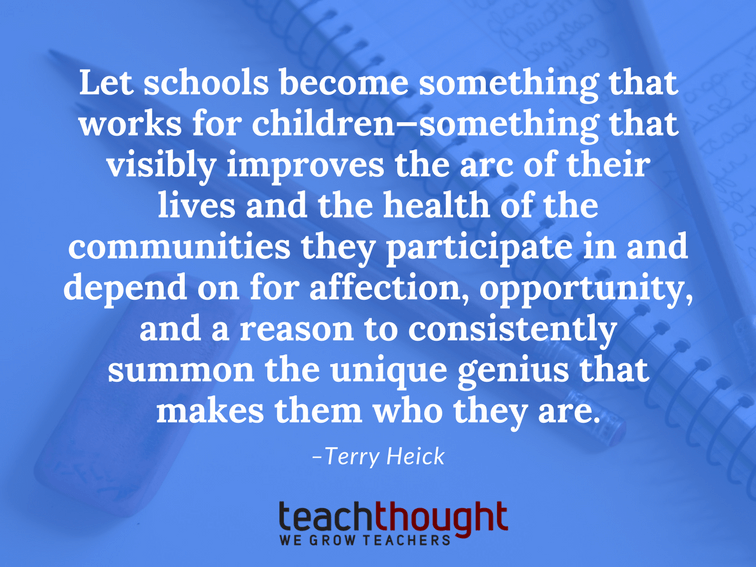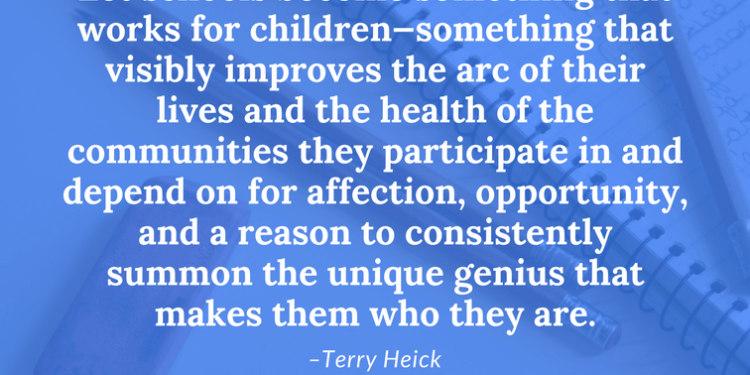

by Terry Heick
Schools, as we know them, are dying.
Shopping, as we know it, is dying.
While both are obvious, one loss seems to breed opportunity while the other makes us hold on for dear life.
Why?
First, some context.
Nestled between the perceived ‘old way’ (learning in person) and ‘new way’ (learning through computer) is Blended Learning.
Blended Learning can be thought of as the bridge between eLearning and brick-and-mortar learning. It is a kind of compromise and a strategy—a way to use existing infrastructure (teachers, buildings, curriculum, etc.) as we create new learning experiences, models, spaces, and outcomes.
See also What Is The Definition Of Blended Learning?
While ‘eLearning’ has a kind of stink to it for many educators, we could all be reminded that early cars were terrible and the vision for what they would become was unclear.
It is only in hindsight do we fully understand what a car ‘is.’ Before there was Honda and Ford and Tesla and gas stations and expressways, there were just noisy and unreliable ‘horse-replacements’ that left many preferring their horse.
Before the automobile—auto (self) mobile (move)—could become a product, it had to be a solution.
During this unsettled and awkward time of transition, every new idea was an idea that could change everything forever; every company was scrambling (often awkwardly) to be the one that solved the problem of moving people around.
We’re in a similar situation in 2022 education, where the pursuit of innovation exceeds the pursuit of quality and many ideas are bad, but it could all turn on a dime with the right idea.
Changing Movements
A few years ago, Apple announced that they were renaming Apple Stores to Apple ‘Town Squares’—places where consumers can gather and ‘experience Appleness.’
Citylab explained the significance.
“Retailers are, very consciously, promoting these in-store ‘experiences’…” It’s a reaction to the fact that buying is now something that can be done anywhere, and that reaction can be detected in a linguistic shift.”
The shift they’re referring to is from ‘store’ to ‘town square’—and ‘town square’ is meant to deliver an ‘experience’ instead of a product or service.
While education and commerce are tonally distinct, they function—more or less—in similar ways. Grocery stores, farmer’s markets, Wal-Mart, Apple and everyone else seeking to participate in a ‘free market’ of Capitalism all exist to fill the perceived need of an individual (who themselves merely represent a ‘demographic’).
The language here is cold because the purpose is, too. These are inherently dehumanizing processes, from the process of industrialization that produces ‘goods’ to the advertising used to promote them which seeks to create a ‘persona’ that a potential buyer recognizes and chooses to ‘participate in’ by handing over their money.
See also 12 Things Schools Could Be Instead Of Schools?
This sense of identity is why celebrity spokespersons are paid so well.
(For example, one can only imagine how much money LeBron James made simply tweeting that he drives a Kia. Kia is an automotive brand that represents the bottom of the US market and whose previous marketing efforts included ‘buy one, get one free’ promotions for cars, so a multi-millionaire claiming to drive one is a bit absurd—which of course is the whole point. Now consumers increasingly associate Kia with LeBron James.)
As consumers, we are trained to feel like we are becoming more ‘individualized’ by accessorizing our existence with the very things that only exist because millions of other people want them, too.
The Language Of Innovation
Profit is the currency of commerce, and visibility and identity and community are powerful strategies to reap that profit.
It could be argued that in education, the highest currency is commonness—everyone working together to identify the same ways to navigate the same curriculum to do well on the same test so we can use the same language to communicate to the same confused parents that their children are going to be just fine.
And standardization, ‘staff buy-in,’ and whole-school and demographic-based data are ways to achieve or demonstrate that commonness. There is safety in numbers, apparently. If we all are struggling, no one is struggling.
“Schlesinger (a professor of history at the University of Minnesota) thinks companies with physical stores will have trouble if they don’t adjust to the fact that the internet has taken away many consumers’ reasons for visiting physical locations in the first place.”
As commercial behemoths seek to rethink spaces in light of their interdependence—that is, shift the use of one space because of the change in another—it’s almost a kind of flipped classroom approach.
But in seeking to merely flip the classroom, we are also retaining the classroom. In a ‘flipped’ setting, only the function of the space is changed—and not changed fluidly in an ongoing way authentic for each situation, but rather simply turned the other way. This is like moving the kitchen to the living room and the living room to the kitchen in hopes of innovating the home.
Changing Consumer Habits
Consider the following scenarios corporate CEOs must consider in this ‘flipped economy.’
Scenario A: Consumers buy both online and in brick-and-mortar stores in a volume sufficient to ensure profit and growth in both online and brick-and-mortar/‘offline’ spaces
Scenario B: Consumers prefer to explore products online but buy via brick-and-mortar
Scenario C: Consumers prefer to buy online and explore (or ‘experience’) products/services via brick-and-mortar (though in a mobile world, even the idea of a single brick-and-mortar space that represents one company may be dated)
Scenario D: Consumers see on and offline spaces as ‘equal’ and equally preferable, with the ability to use both interchangeably without restriction or ‘penalty’ (e.g., paying higher prices to shop in a store, or sacrificing the security of bank cards by shopping online).
Obviously, companies would prefer Scenario A above. When that doesn’t happen, companies have to rethink ‘spaces.’ Spaces are just means of reaching consumers, requiring different strategies based on the respective strength of each. These shifts are opportunities, and exactly how slow-to-adapt companies die off.
(Take a walk through a Sears department store—if there are any left around you—and tell me you can’t smell the unique sadness of a once-proud, dying company.)
Disruption As Cause
The internet sent companies scrambling.
Mobile adoption sent companies scrambling.
Social media and social-media-as-customer-service sent companies scrambling.
Voice search is sending companies scrambling.
In consumer markets, if Amazon threatens to create brick-and-mortar grocery stores with frictionless checkout, the rest of the industry seeks out the brightest minds to respond with the smartest strategies.
In education, there is very little that sends anyone scrambling beyond test scores. Imagine if the only thing that spurred innovation at Apple was profit margin, or if the only thing that caused Google to rethink its business model was decreasing ad sales. Sales and profit are effects, and by the time financial trends become clear, it can be too late.
The brick-and-mortar department store as we know it is dead, and keeping it alive, as it is, is only keeping it from what it can become—keeping it from changing shape into something that parallels the look and form of the world changing around it.
So let it change shape.
Change Or Forever Lose The Ability To Change
If we return to the Citylab article, there is a sentence that should stand out for teachers.
“Retailers are, very consciously, promoting these in-store “experiences”…” It’s a reaction to the fact that buying is now something that can be done anywhere, and that reaction can be detected in a linguistic shift.”
Now, replace the word ‘buying’ with ‘learning’ and you’ll start to see why this is worth understanding.
“It’s a reaction to the fact that learning is now something that can be done anywhere…”
Learning can be done ‘from anywhere.’ Though equity in education keeps this from translating to all students with cutting-edge devices devouring Google-delivered data over broadband WiFi, mobile learning doesn’t necessitate mobile technology. Learning can be done with anything.
Learning can be used anywhere, qualified anywhere, and authenticated anywhere, too. But there’s a catch.
As public education exists today, learning…
…doesn’t begin with love or racism or the loss of watersheds or topsoil or forests, nor does it end with people or familial legacies or needs unique to that student.
…doesn’t begin with a brilliant or crazy or fun or crucial idea.
…doesn’t begin or end with a useful skill suited to a student well-suited to that skill.
…begins and ends, rather, in a school—a school guided by the hope of increasingly efficient ‘mastery’ of a more or less universal (national) curriculum.
Instead, let it begin and end in the genius of a child’s imagination.
Let it begin and end in the crushing poverty that has hung on the neck of their family for generations.
Let it begin with a global crisis or local opportunity or in an app that uses deeply personalized algorithms to deliver the right content at the right time to that student.
Let the systems and rules and buildings and funding and roles that make it all happen be disruptable by market forces similar to those that force companies to innovate or die. Shielding schools from these forces ensures that school, as an idea, never changes shape.
K-12 has been positioned as something to provide ‘college readiness.’ The purpose of school is not, and has never been, to ‘get kids ready for college.’
So let schools become something else.
Let them become something that works for children—something that visibly improves the arc of their lives and the health of the communities they participate in and depend on for affection, opportunity, and a reason to consistently summon the unique genius that makes them who they are.



















